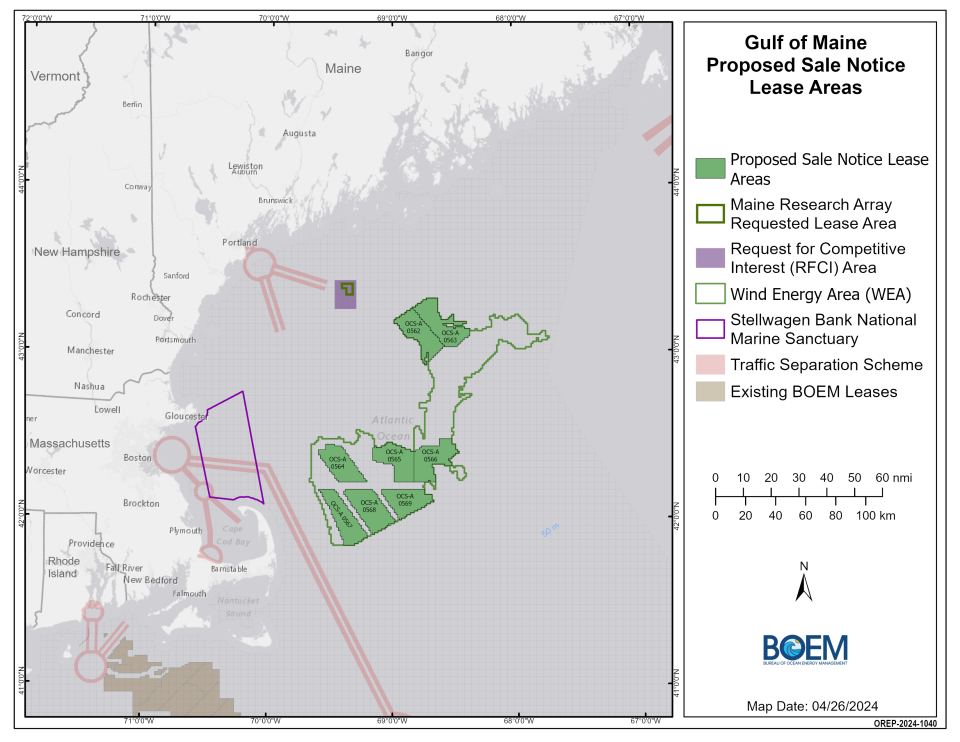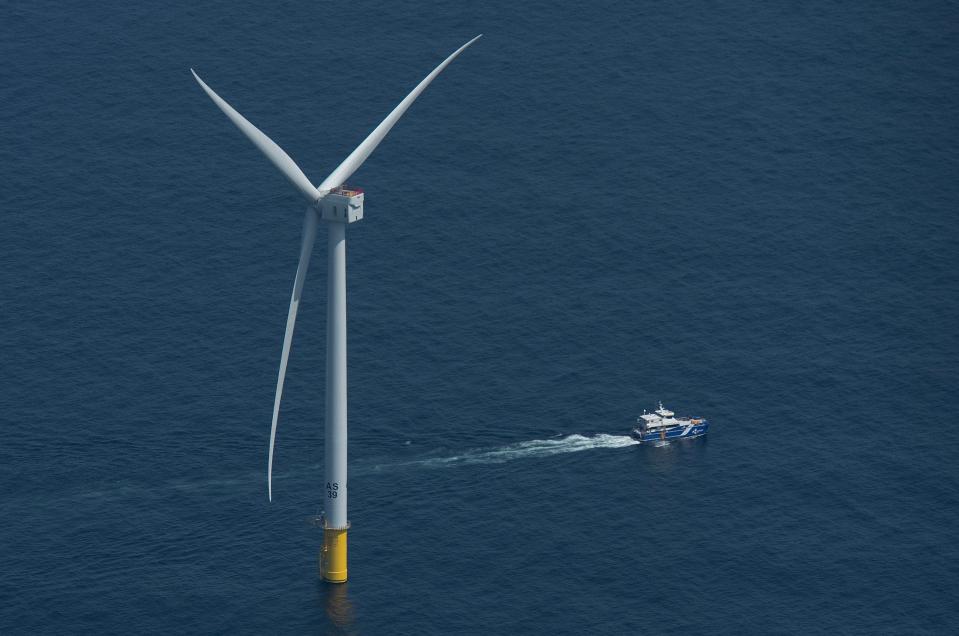As new wind lease areas are eyed off Cape Cod, leaders seek 'a seat at the table'
- Oops!Something went wrong.Please try again later.
- Oops!Something went wrong.Please try again later.
Three ocean areas east of Cape Cod may be some of the next marine real estate to be auctioned for offshore wind energy production, with some turbines possibly distantly visible, in very clear conditions, from the Atlantic Ocean bluffs in Truro.
Located due east of Wellfleet and Truro, the areas total 363,305 acres starting about 24 miles offshore and stretching eastward. They are among eight potential lease areas — adding up to nearly a million acres — that the federal Bureau of Ocean Energy Management has delineated for offshore wind projects off the coasts of Massachusetts, New Hampshire and Maine.
In anticipation of the sale, local legislators are working to ensure the outermost Cape towns are part of the discussion and residents are kept well-informed. The federal government is also gathering public comments.
"I'm proud of the progress we've made with Vineyard Wind and encouraged to see additional projects. Of course, the details always matter on these projects," state Sen. Julian Cyr, D-Truro, said.
Vineyard Wind 1 is the country's first industrial-sized offshore wind farm, located south of Martha's Vineyard and Nantucket, according to the company.

Gulf of Maine a new host to offshore wind
The first-ever offshore wind energy auction in the Gulf of Maine Wind Energy Area is slated to open this fall, with additional lease areas proposed to be added in 2028. According to federal agency, together the first eight areas have the potential to generate 15 gigawatts of renewable energy, which would power more than five million homes.
Besides the proposed areas east of Wellfleet and Truro, three of the eight lease areas are due east of Boston, beyond the eastern boundary of the Stellwagen Bank National Marine Sanctuary at the mouth of Massachusetts Bay. Two are due east of Portsmouth, New Hampshire and southeast of Portland, Maine.
"In identifying these areas, BOEM prioritized avoidance of offshore fishing grounds and identification of vessel transit routes, while retaining sufficient acreage to support the region’s offshore wind energy goals," the agency stated in a release.
Keeping Cape Cod towns in the loop
On Tuesday, Cyr and state Rep. Sarah Peake, D-Provincetown, hosted a virtual meeting with town managers and Select Board members from Chatham, Orleans, Eastham, Wellfleet, Truro and Provincetown so they could learn more about the plans.
"So, what we've been working to do is to make sure that Chatham up to Provincetown have a seat at the table," Cyr said.
Bureau of Ocean Energy Management representatives "answered a lot of questions" for the local officials, he said, "and we were also joined by stakeholders from Martha's Vineyard who shared their experience and best practices related to their engagement with Vineyard Wind."
He and Peake are also pushing for the federal agency to expand its outreach to include public sessions for residents of the easternmost Cape Cod towns to learn more about the plans and ask questions.
"It's understandable that Outer Cape and Lower Cape residents have questions and concerns about these projects. I think it's essential that BOEM have a presence in our communities," Cyr said. He said so far the closest the agency has come with public sessions is Plymouth.

How could new lease areas affect the Cape?
Contrary to circulating rumors, projects offshore of the easternmost Cape Cod towns are not expected to make landfall there. Interconnection points, according to Cyr, "would probably be Salem or Plymouth" at the site of the former Pilgrim nuclear power plant.
Nick Krakoff, a senior attorney with the Conservation Law Foundation, also said it is "very unlikely" for cables to come ashore on the outermost parts of the Cape, which is dominated by the Cape Cod National Seashore, especially since coming ashore there would necessitate routing cables a long distance to connect into the ISO-New England power grid.
Krakoff anticipates cables would interconnect in Boston or Plymouth, and possibly Portsmouth, New Hampshire.
"The issue is, they want to interconnect to the grid where most of the demand or load is," he said. "Right now, there's some grid constraints basically from Maine down to Boston." The same holds true for the power grid on the eastern and outermost parts of Cape Cod.
Seashore spokesperson Linzy French in an email on Tuesday noted that the National Park Service is also "actively participating" in the federal Bureau of Ocean Management's Gulf of Maine commercial offshore wind review and analysis.
The National Park Service's role in the planning is to provide on ongoing expertise on how the project may affect the Cape Cod National Seashore and other sites where the service has an administrative role, French wrote.
Could offshore wind farms be seen from shore?
Should projects move forward off the Cape, visibility of any turbines from shore would be limited, according to Cyr.
"My understanding is they may be visible on a clear day from the Truro bluffs," he said, but it would depend on the height of the turbines and how clear conditions are.
Cyr said the biggest questions he has "are related to environmental and marine life impacts, how these projects would interact with our fisheries, and about the lighting of these projects at night." He, for one, demands that everything possible is done "to preserve the dark skies we have."
Beyond that, Cyr said there could be a good opportunity for the eastern and outer parts of Cape Cod to host an offshore wind operations and maintenance facility, "which could mean dozens of year-round labor jobs" for local residents.
Advocating for the marine environment
Krakoff said the Conservation Law Foundation has also been deeply involved with the process to designate the proposed lease areas, which join proposals for new offshore wind areas in other parts of the country, from Oregon and California to the central Atlantic coast, the Gulf of Mexico and Hawaii. Initially, he said, the federal Bureau of Ocean Energy Management proposed designating almost the entire Gulf of Maine for potential offshore wind production.
"Over the past two years, they've winnowed it down considerably," he said. "Throughout the process, we've advocated for BOEM to exclude certain areas."
The foundation's advocacy has focused on protection of critically endangered North Atlantic right whales, as well as sensitive populations and habitats.
Overall, Krakoff said, "we have more general concerns about how do you develop (offshore wind) responsibly" to minimize impacts on right whales, Atlantic cod and "the benthic and rocky habitats that are important to a lot of marine species."
Public invited to comment
A public comment period on the lease sites is coming to a close on July 1. The Bureau of Ocean Energy Management is specifically seeking feedback on various aspects of the proposed lease areas, including size, orientation and location of the eight lease areas and which areas, if any, should be prioritized for inclusion or exclusion from this year's scheduled lease sale.
To submit comments, visit Regulations.gov. In the search box, enter BOEM-2024-0026 and click “Search.” Follow the instructions to submit public comments.
Meanwhile, a second public comment period for a draft environmental assessment just opened on June 21 and will continue through July 22. The assessment considers site characterization surveys — such as biological, archeological, geological, and geophysical surveys and core samples — as well as installation of meteorological buoys expected to occur following issuance of leases, according to the agency.
To submit comments, visit Regulations.gov and enter BOEM-2024-0030 into the search box.
Virtual meetings are also scheduled for reviewing the draft environmental assessment, on Monday, July 8 at 1 p.m. and Wednesday, July 10 at 5 p.m. Registration links for each meeting are available at www.boem.gov/renewable-energy/state-activities/maine/gulf-maine
Heather McCarron can be reached at hmccarron@capecodonline.com, or follow her on X @HMcCarron_CCT
The Cape Cod Times is providing this coverage for free as a public service. Please take a moment to support local journalism by subscribing.
This article originally appeared on Cape Cod Times: Wind farm areas east of Truro, Wellfleet potential in federal auction

